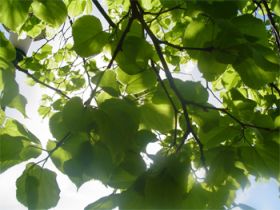The source of methane in the light
Plants store a greenhouse gas, and release another. While they retain carbon dioxide, they release methane although in small amounts. This has been confirmed by scientists from the Max Planck Institute of Chemistry, Utrecht University and the Institute of Agricultural and Biological Food (Belfast).
In two new studies, they also verified that some greenhouse gases are derived from pectin, a substance that plants use to create their supporting structures. The study also detected UV rays that increased methane production. This also explains why researchers cannot find plant methane because they grow plants under light sources that do not emit UV. (New Phytologist, May 9, 2008; Biogeosciences sheet)
Two years ago, their statement created a stir: Frank Keppler and his colleagues at the Max Planck Institute of Nuclear Physics (Heidelberg) first observed plants releasing methane into the air. This means that in normal air conditions bacteria cannot create methane bubbles like in marshes. The study also showed that plants contribute a significant part of methane in the atmosphere.
The fierce debate took place not only around the global significance of the release of methane from plants. Many researchers even doubt whether it is true that plants release methane while it is a greenhouse gas 25 times more harmful to the environment than carbon dioxide. However, Frank Keppler, who was working on the study at the Max Planck Institute of Chemistry, and his colleagues gave evidence from specific experiments to prove that plants actually release methane in large quantities when UV light.
Recently, Tom Dueck, a scientist at Wageningen University in the Netherlands, acknowledged the value of Keppler's discovery. This makes Keppler very pleased. Dueck once suspected Keppler's discovery that he and his colleagues were unable to produce methane greenhouse gases. However, it is because they grow plants in greenhouses under artificial light that does not contain UV rays.

The source of methane in the sun: Plants create greenhouse gases under UV rays - part of the sun.Large amounts of greenhouse gases are released from pectin - bio-polymers form the supporting structure of flowers and leaves.(Photo: Frank Keppler)
Frank Keppler and colleagues, some at Utrecht University, examined both fresh and dry ingredients from 20 different plants. Keppler said: 'This time, we actively use only parts of plants like leaves, because it is very likely that the processes that take place in the life of plants make the results false. The first group of experimental plants was exposed to UV light. At the same time another group is heated to 100 ° C and the third group is monitored in a temperature range of 20 to 100º C. "
In this process, scientists have determined that not all plants release the same amount of methane. However, the stronger the source of illumination, the more greenhouse gases are released. The amount of gas released is higher when the temperature is simultaneously pushed up. Without UV radiation and temperatures below 22º C, plants release methane 100 to 1000 times lower.
From 80º C, the concentration of release is increased when placed under UV light. In addition, heat causes methane to be released less when scientists heat up and cool plants several times successively. However, if UV light is turned on a sample several times, the amount of methane emitted is always the same. Keppler said: 'UV rays clearly use a different reaction mechanism than temperature to release this gas.'
One component from which UV rays produce methane during photochemical processes is pectin - a type of polysaccharide that many plants use as structural materials. It includes a number of methoxyl groups with an incomplete chemical structure of methane. Scientists found instructions about where methane was formed in studies two years ago. Currently, in a study using isotopes, they have explicitly demonstrated that this mechanism exists. They replaced the hydrogen atom in the group with deuterium - a solid hydrogen - and found deuterium in methane.
However, not methane can only be formed by this method because in the experiment with UV rays, methane can also form without deuterium. In fact, cellulose also produces methane under UV light, although not as much as pectin. Unlike pectin, cellulose does not have methoxyl groups. Frank Keppler said: 'At the moment we do not know about the second mechanism. Because so far we have only explored some of the processes involved in the process of plant release of methane. Understanding on a global scale is very difficult. '
Reference publications
Frank Keppler, John TG Hamilton, W. Colin McRoberts, Ivan Vigano, Marc Braß and Thomas Röckmann - The methoxyl group in plant pectin is the precursor of methane in the atmosphere: evidence from deuterium studies; New Phytologist, May 9, 2008.
Ivan Vigano, Huib van Weelden, Rupert Holzinger, Frank Keppler, Andy McLeod and Thomas Röckmann - Effect of UV and temperature on methane release from biomass plants and structural components - Biogeosciences sheet.
- Graphene films can turn methane gas into an energy source
- The University of London developed a methane absorption spectrum
- Harm of artificial light
- The mystery of infrared light source emitted from supernova remnants
- Siberian lakes, a source of huge methane emissions
- The Arctic Ocean emits greenhouse gases
- New Chinese power generation
- Gulf Stream warm currents are releasing methane from the sea floor
- Tracing the source of the mysterious explosion off the Italian coast
- Russia develops methane boosters
- Underwater power plant in Rwanda
- Scientists have successfully studied rice varieties with low methane emissions
 Why do potatoes have eyes?
Why do potatoes have eyes? 'Tragedy' the world's largest carnivorous life: Death becomes ... public toilet
'Tragedy' the world's largest carnivorous life: Death becomes ... public toilet Tomatoes were once considered 'poisonous' for 200 years
Tomatoes were once considered 'poisonous' for 200 years Detecting microscopic parasites on human face
Detecting microscopic parasites on human face